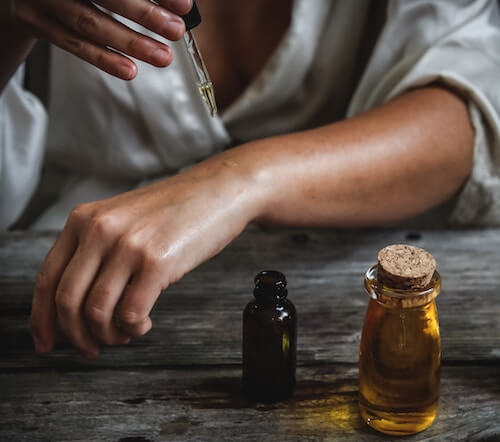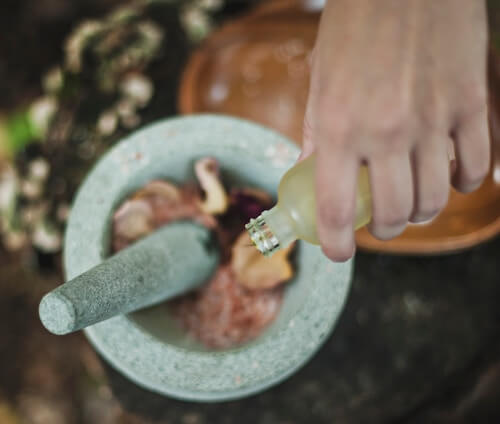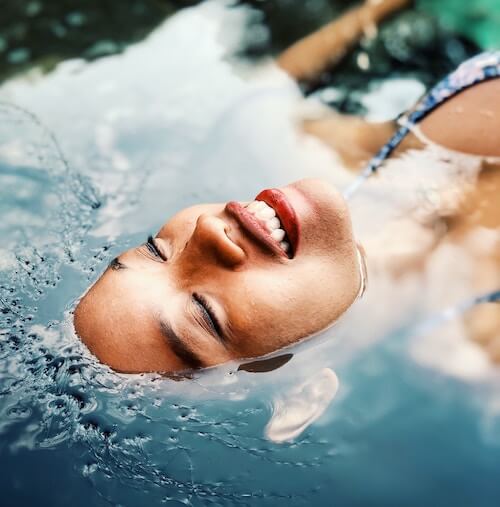Your skin is so dry and dull that you can literally draw on it. In spite of all the exfoliation and moisturising, it still feels tight and rough. You just want to get rid of dry skin as soon as possible.
You have used oils, butter and everything OTC available in the drugstore. Yet the problem seems to persist.
In fact, it worsens during winters. Your body butter gives you temporary relief. But nothing has given you a permanent solution for your scaly skin.
You have been struggling to find that one holy grail that will give you glowing, soft skin . You know you need a sustainable solution but you are not sure what.
Though you have been using natural products but nothing seems to work. If the answer to all of these things is a big yes, I think there is something that you might have been doing wrong in the first place.
Ayurveda, a traditional medicine science, says that the answer lies in how you take bath.
Bathing is a therapeutic ritual in Ayurveda. When done correctly it can increase the Ojas(body’s vital energy), balance your doshas and make your skin supple, soft and scar-free. You can get rid of dry skin naturally, quickly and efficiently.
Understanding dry skin
Dry skin needs warmth. It needs exfoliation and it needs to be healed internally.
Dry skin in Ayurveda often corresponds to emotions of fear and panic.
When you are stressed about something or you are fearful about something, it increases the Vata energy in your body.
The cooling and drying Dosha will make your skin dry and rough.
If you have dry skin, take some time to introspect if something has been bothering you lately.
Writing down your thoughts will help you understand yourself better and will allow you to focus better on the things that need attention.
Raw salads and veggies should not be consumed by the people with dry skin. Slightly steamed and boiled veggies works wonders.
Apart from all of this, a good Ayurvedic bath will help you get rid of dry skin. Let us understand more in details how an Ayurvedic bath works and what are the steps.
The Ayurvedic way of bathing to get rid of dry skin
Soft, supple and shiny skin is a dream of every woman. They keep looking for the right products, the right brand, the right recipe to find a solution for their dry and dull skin.
Most of us, when it comes to bathing, instantly think about our favourite shower gel and its fragrance. However, in Ayurveda bathing is much more than physical cleansing. It is a spiritual and therapeutic activity that is performed to recharge and rejuvenate your body every single day.
Step 1: Oil Massage
The first step to a perfect bath starts with moisturising your body with a nice and soothing oil like coconut, sesame or any Ayurvedic massage oil.
A daily Abhyanga ( massage) will get the blood flowing in the body. This step is crucial to maintain the shine and glow of the body.

It also removes dirt from clogged pores. It also provides a surge of moisture to the cells and being natural, there are no side-effects.
Take decent amount of oil in your palms and massage thoroughly for 5 minutes. Let your body soak in the moisture for a few minutes.
Due to a sedentary lifestyle, there often is some blood stagnation in our bodies. A daily massage removes stagnation.
It increases your metabolism and makes you sweat, thus, opening the pores. Sweat keeps your body moisturised and dewy.
Step 2: Exfoliation
Second step in the process is exfoliation. We usually treat our skin very softly.
In Ayurveda, if your skin is not rubbed extensively every day, it will develop wrinkles early on.
Ayurveda recommends exfoliating your body daily. The exfoliation should be good and not very harsh.
Use a natural Ayurvedic body cleanser is made of herbs and clay instead of soap.
Soap dries out skin and rips away all the natural oils from skin. This removes excess oil used for Abhyanga or massage and leaves the right amount of moisture on the skin.
The more you exfoliate, the more open your pores are will be and more will be the elimination of waste from the skin.
There are different ways of exfoliation in Ayurveda but this is the easiest one and should be performed daily.
Bathing with a mix of clays, flours, flower petals is recommended. For extremely flaky and dry skin, mix coarse rice flour and rose petals in yogurt or milk.
Doing this once a week will remove the dead skin and make it smooth.
The more variety you use, the more will be the glow as you will be feeding your skin different foods.

For a daily cleanser, mix gram-flour with rose petals, cinnamon powder, liquorice powder and neem leaves.
You can alternatively choose any clay like fuller’s earth and dry neem leaves to make a paste. Apply all over your body after oiling and massage extensively.
Drying your body after bathing
Using a cotton towel to dry your body is recommended in Ayurveda. The towels available in the market today are plush and soft. They barely produce any heat while rubbing.
Your skin has seven layers and toxins in the body often clog several layers. Some people do not sweat at all and store excess heat in the body.
One should use a rough cotton towel to dry out the body. Rubbing using a cotton towel removes dead skin from wet and moist skin. This leaves it fresh and glowing over the long time.
Doing this every day will make way for the toxins to move out. The body temperature will go down and the pores will open up for sweating.
FAQ’s
What is the ideal time of bathing?
According to Ayurveda, early morning before sunrise is the ideal time to take a bath or cleanse your body.
Your body is in a restful state during the night and generates a lot of heat in the body.
When you take a bath, you remove excess heat from the body, making it cool and calm.
If you do not bathe early morning, your body temperature keeps increasing. This excess heat impairs digestion and causes the skin to break out.
In some cold countries, taking a shower in the evening before sleeping is the norm. Although, people should follow the local practices, this one is not recommended.
When you do not take a shower every day your body does not wake up completely and you feel lazy and lethargic.
Also, the dirt accumulated over the body overnight clogs your pores.
Also, do not take bath immediately after waking up. This will send your system in a shock. Waiting for 30-45 minutes after waking up is the perfect time.
The first few minutes of waking up should be spent introspecting and reflecting over yourself.
Can we eat anything before bathing?
It is imperative to take a bath on an empty stomach. When you eat something, your body begins the process of digestion.
The fire in your belly or Agni is responsible for digestion.
But if you take a bath immediately after your meal, the digestion process will cool down as bathing lowers the body temperature.
The fire will not be as strong and digestion will be poor.
The undigested food becomes toxic when it remains for a long time in the system.
Bathing should be done before eating or having tea in the morning.
What should be the ideal temperature of water?
We all love bathing in warm water. But hot water makes our skin dry and rough and our bodies sleepy. Ayurveda does not recommend bathing with hot water.
In fact the ideal temperature is 2-3 degrees lower than the body temperature.
Even during winters when the water is chilled, Ayurveda recommends to keep it slightly warm so that you don’t fall sick. But bathing with hot water is a strict no no.
Hot water makes your hair brittle and increases premature greying. It opens up pores of your skin leaving them vulnerable to dirt and infections.
Changing this habit will help you get rid of your dry skin in just a few days.
If you do plan to take a hot shower, it is recommended to end it with some cold water. This closes the pores and increases immunity.
How to use water while bathing?
Using water to bathe is therapeutic. Ayurveda recommends to use top to toe approach while taking a shower.
Our heads should go in the water first and then the rest of our body. The water wakes up your mind and increases blood flow.
The water removes excess heat from our heads and regulates the blood flow in the ideal direction.
If you don’t wash your hair everyday, start with your face.
How many times in a day should you bathe?
It is not recommended to take a shower more than once.
Ayurveda considered our resources scared and considers a waste of time and resources to bathe twice in a day.
Your body needs cleansing once a day. If you feel sweaty and want to clean yourself, rub your body with a wet towel instead.
Chakshu is a US alliance certified yoga teacher, a biotechnologist and an Ayurveda evangelist. Her passion is to help people live a toxic-free life, emotionally and chemically. She loves reading self-help books. When she is not writing, she is busy thinking about life.


